The global AI industrial defect detection market is projected to grow from USD 2,660.8 million in 2025 to approximately USD 6,071.8 million by 2035, recording an absolute increase of USD 3,411.0 million over the forecast period. This translates into a total growth of 128.2%, with the market forecast to expand at a compound annual growth rate (CAGR) of 8.6% between 2025 and 2035. The overall market size is expected to grow by nearly 2.3X during the same period, supported by the rising adoption of artificial intelligence technologies in manufacturing quality control and increasing demand for automated inspection solutions in diverse industrial sectors including electronics, automotive, and precision manufacturing applications.
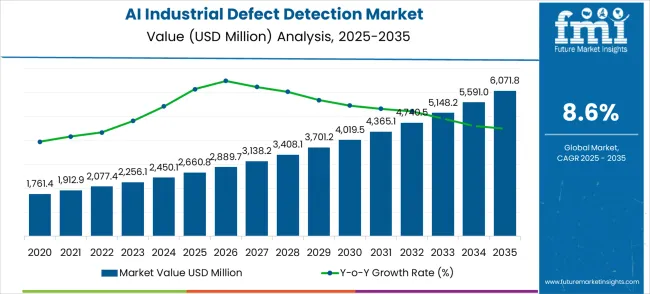
Between 2025 and 2030, the AI industrial defect detection market is projected to expand from USD 2,660.8 million to USD 4,019.5 million, resulting in a value increase of USD 1,358.7 million, which represents 39.8% of the total forecast growth for the decade. This phase of growth will be shaped by rising penetration of deep learning algorithms in manufacturing processes, increasing demand for real-time quality control solutions, and growing adoption of computer vision technologies in automated production lines. Equipment manufacturers are expanding their AI-powered inspection capabilities to address the growing complexity of modern manufacturing quality requirements and defect detection accuracy demands.
| Metric | Value |
|---|---|
| Market Value (2025) | USD 2,660.8 million |
| Market Forecast Value (2035) | USD 6,071.8 million |
| Market Forecast CAGR | 8.6% |
The AI industrial defect detection market commands a significant share within the artificial intelligence market, contributing around 9% due to its application in automated quality inspection and real-time defect detection using AI algorithms. Within the industrial automation market, it accounts for approximately 12%, driven by the increasing demand for autonomous systems that can identify defects in production lines. In the machine vision systems market, the share is about 10%, as AI-powered defect detection is a key use case for advanced imaging technologies. The manufacturing inspection systems market holds around 8%, as AI integration offers enhanced accuracy and efficiency in defect detection processes. Finally, in the quality control and assurance market, the AI industrial defect detection market holds about 7%, reflecting its essential role in ensuring product integrity and minimizing defects during production. Together, these figures highlight the growing role of AI in elevating quality standards and operational efficiency in industrial sectors.
Market expansion is being supported by the rapid increase in Industry 4.0 implementations worldwide and the corresponding need for intelligent quality control systems that provide real-time defect identification and automated inspection capabilities in modern manufacturing environments. Modern production facilities rely on AI-powered defect detection to deliver consistent product quality and comprehensive quality assurance including electronics assembly, automotive component manufacturing, and precision device production. Even minor defect detection delays can require comprehensive quality control protocol adjustments to maintain optimal manufacturing standards and product reliability.
The growing complexity of manufacturing quality requirements and increasing demand for zero-defect production solutions are driving demand for AI industrial defect detection systems from certified technology providers with appropriate machine learning capabilities and manufacturing expertise. Manufacturing companies and quality control departments are increasingly requiring documented detection accuracy and system reliability to maintain production quality and operational effectiveness. Industry specifications and quality standards are establishing standardized defect detection procedures that require specialized AI technologies and trained quality engineers.
The AI Industrial Defect Detection market is entering a new phase of accelerated growth, driven by demand for manufacturing automation, quality control advancement, and evolving Industry 4.0 standards. By 2035, these pathways together can unlock USD 1.2-1.5 billion in incremental revenue opportunities beyond baseline growth.
Pathway A -- Deep Learning Technology Leadership (Neural Network Solutions) The deep learning segment already holds the largest share due to its superior pattern recognition capabilities. Expanding neural network architectures, transfer learning applications, and automated training systems can consolidate leadership. Opportunity pool: USD 350-450 million.
Pathway B -- Electronics Manufacturing Excellence (PCB & Semiconductor Inspection) Electronics manufacturing accounts for the largest application share. Growing miniaturization trends, especially in consumer electronics and automotive electronics, will drive higher adoption of AI-powered micro-defect detection. Opportunity pool: USD 280-360 million.
Pathway C -- Automotive Quality Control Expansion (Vehicle Component Inspection) Automotive manufacturing requires stringent quality standards for safety-critical components. AI solutions designed for automotive defect detection (surface inspection, assembly verification, paint quality) can capture significant growth. Opportunity pool: USD 200-260 million.
Pathway D -- Edge AI and Real-Time Processing Manufacturing environments require immediate defect detection feedback. Edge AI solutions that process inspection data locally without cloud dependency offer premium positioning opportunities. Opportunity pool: USD 160-210 million.
Pathway E -- Unsupervised Learning Innovation Unsupervised learning reduces training data requirements and adapts to new defect types automatically. Advanced anomaly detection systems for novel defect discovery create new market segments. Opportunity pool: USD 120-160 million.
Pathway F -- Multi-Modal Inspection Systems Combining visual inspection with thermal, X-ray, or ultrasonic data provides comprehensive defect detection. Integrated multi-sensor AI systems offer advanced capabilities for complex manufacturing environments. Opportunity pool: USD 100-130 million.
Pathway G -- Small and Medium Enterprise Penetration SME manufacturers require cost-effective AI solutions with simplified deployment. Affordable, plug-and-play AI inspection systems for smaller manufacturers create volume opportunities. Opportunity pool: USD 80-110 million.
Pathway H -- Predictive Quality Analytics AI systems that predict potential defects before they occur offer significant value. Predictive quality control and process optimization create recurring revenue opportunities through software and services. Opportunity pool: USD 60-80 million.
The market is segmented by detection technology, application, and region. By detection technology, the market is divided into defect detection based on deep learning, defect detection based on traditional computer vision, defect detection based on unsupervised learning, and others. Based on application, the market is categorized into electronics manufacturing, automobile manufacturing, metal processing, apparel and textiles, packaging, aerospace and defense, photovoltaics, and others. Regionally, the market is divided into North America, Europe, East Asia, South Asia & Pacific, Latin America, and Middle East & Africa.
In 2025, the defect detection based on deep learning segment is projected to capture around 56% of the total market share, making it the leading technology category. This dominance is largely driven by the widespread adoption of advanced neural network architectures that provide superior pattern recognition and defect classification capabilities, catering to a wide variety of complex manufacturing inspection requirements. Deep learning-based detection technology is particularly favored for its ability to learn complex defect patterns and deliver consistent detection performance across diverse product types, ensuring operational flexibility and accuracy improvement. Electronics manufacturers, automotive producers, precision device fabricators, and aerospace companies increasingly prefer deep learning approaches, as they meet stringent quality requirements without requiring extensive manual feature engineering or complex rule-based programming.
The availability of well-established deep learning frameworks, along with comprehensive training datasets and technical support from leading AI solution providers, further reinforces the segment's market position. Additionally, this technology category benefits from consistent demand across regions, as it is considered a practical high-performance solution for manufacturers requiring sophisticated defect recognition capabilities. The combination of accuracy, adaptability, and scalability makes deep learning-based defect detection systems a preferred choice, ensuring their continued popularity in the AI industrial inspection market.
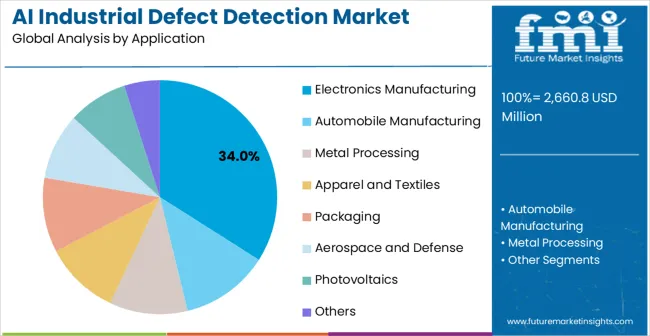
The electronics manufacturing segment is expected to represent 34% of AI industrial defect detection demand in 2025, highlighting its position as the most significant application sector. This dominance stems from the unique operational needs of electronics production environments, where microscopic defects and component placement accuracy are critical to product functionality and reliability. Electronics manufacturing facilities often feature high-speed assembly lines that process thousands of components throughout extended production cycles, requiring rapid and precise defect detection systems. AI-powered defect detection solutions are particularly well-suited to these environments due to their ability to identify minute defects, component misalignments, and surface anomalies at production speeds, even during continuous manufacturing operations.
As electronics companies globally advance toward smaller component sizes and higher integration density, the demand for AI-based inspection systems continues to rise. The segment also benefits from increased complexity in electronic device manufacturing, where producers are increasingly prioritizing defect-free production and comprehensive quality control as essential competitive advantages. With electronics manufacturers investing in advanced production technologies and quality enhancement systems, AI industrial defect detection provides an essential solution to maintain superior product quality. The growth of miniaturized electronics, advanced semiconductor packaging, and high-density circuit boards, coupled with increased focus on zero-defect manufacturing, ensures that electronics manufacturing will remain the largest and most stable demand driver for AI industrial defect detection solutions in the forecast period.
The AI Industrial Defect Detection market is advancing rapidly due to increasing Industry 4.0 adoption and growing recognition of artificial intelligence advantages in quality control over traditional inspection methods. However, the market faces challenges including high initial system implementation costs compared to conventional inspection equipment, complex AI model training requirements for specific defect types, and varying data privacy regulations across different geographic regions. Performance optimization efforts and AI algorithm advancement programs continue to influence system development and market adoption patterns.
The growing development of edge computing technologies is enabling real-time AI processing with reduced latency characteristics and enhanced system responsiveness. Advanced edge AI processing and optimized neural network deployment provide superior inspection performance while maintaining cost-effective hardware utilization. These technologies are particularly valuable for high-speed manufacturing operations and quality control departments who require reliable defect detection performance that can support demanding production environments with consistent accuracy.
Modern AI industrial defect detection providers are incorporating advanced unsupervised learning algorithms and anomaly detection systems that enhance defect discovery capabilities and reduce training data requirements. Integration of self-learning neural networks and adaptive anomaly detection enables superior flexibility and comprehensive defect identification capabilities. Advanced unsupervised learning features support operation in diverse manufacturing environments while meeting various quality requirements and inspection specifications.
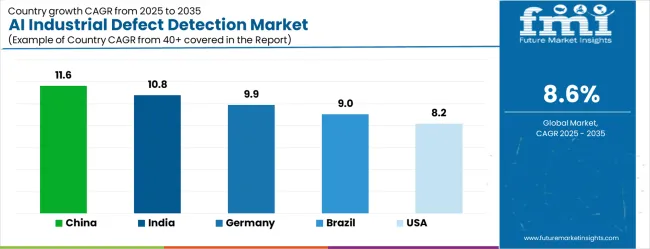
| Country | CAGR (2025-2035) |
|---|---|
| China | 11.6% |
| India | 10.8% |
| Germany | 9.9% |
| Brazil | 9.0% |
| United States | 8.2% |
| United Kingdom | 7.3% |
| Japan | 6.5% |
The AI industrial defect detection market is experiencing strong growth, with China leading at an 11.6% CAGR through 2035, driven by massive manufacturing sector digitization and increasing adoption of artificial intelligence technologies in quality control across electronics, automotive, and precision manufacturing sectors. India follows at 10.8%, supported by rising manufacturing industry modernization and growing awareness of AI-powered quality control solutions for export-oriented manufacturing. Germany grows robustly at 9.9%, integrating AI defect detection technology into its established automotive and precision manufacturing infrastructure. Brazil records 9.0%, emphasizing manufacturing quality enhancement and industrial automation advancement initiatives. The United States shows substantial growth at 8.2%, focusing on advanced manufacturing and AI technology innovation. The United Kingdom demonstrates strong progress at 7.3%, maintaining established manufacturing applications and AI research leadership. Japan records 6.5% growth, concentrating on precision manufacturing and ultra-high quality production standards.
The report covers an in-depth analysis of 40+ countries, the top-performing countries are highlighted below.
Revenue from AI industrial defect detection systems in China is projected to exhibit the highest growth rate with a CAGR of 11.6% through 2035, driven by extensive manufacturing sector digitization initiatives and increasing demand for automated quality control solutions in electronics, automotive, and precision manufacturing industries. The country's aggressive Industry 4.0 implementation and expanding AI technology capabilities are creating significant demand for intelligent defect detection systems. Major manufacturing companies and technology providers are establishing comprehensive AI deployment programs to support the increasing requirements of quality control departments and production facilities across industrial manufacturing centers.
National manufacturing upgrade initiatives are supporting establishment of smart factory technologies and AI-powered quality control centers, driving demand for advanced defect detection equipment throughout major industrial development zones. Manufacturing digitization programs are facilitating adoption of artificial intelligence technologies that enhance production quality capabilities and inspection accuracy across manufacturing supply chains.
Revenue from AI industrial defect detection systems in India is expanding at a CAGR of 10.8%, supported by increasing manufacturing industry modernization and growing awareness of artificial intelligence advantages in quality control applications. The country's expanding manufacturing sector and rising export quality standards are driving demand for advanced AI-powered inspection solutions. Manufacturing companies and quality control departments are gradually implementing professional-grade AI defect detection equipment to maintain production standards and international competitiveness.
Manufacturing industry growth and industrial automation development are creating opportunities for technology suppliers that can support diverse production requirements and quality specifications. Professional training and development programs are building technical expertise among manufacturing engineers, enabling effective utilization of AI defect detection technology that meets manufacturing standards and quality requirements.
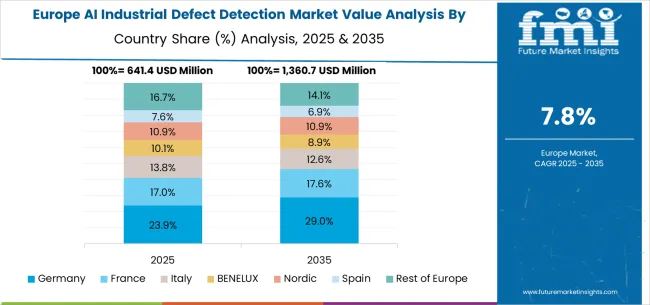
Demand for AI industrial defect detection systems in Germany is projected to grow at a CAGR of 9.9%, supported by the country's emphasis on automotive manufacturing quality standards and precision engineering technology adoption. German automotive manufacturers and precision engineering companies are implementing cutting-edge AI inspection systems that meet stringent performance requirements and technical specifications. The market is characterized by focus on system reliability, detection accuracy, and compliance with comprehensive automotive and manufacturing engineering standards.
Automotive manufacturing industry investments are prioritizing advanced AI technology that demonstrates superior performance and reliability while meeting German quality and technical standards. Professional certification programs are ensuring comprehensive technical expertise among manufacturing and quality engineers, enabling specialized AI inspection capabilities that support diverse automotive applications and precision manufacturing requirements.
Revenue from AI industrial defect detection systems in Brazil is growing at a CAGR of 9.0%, driven by increasing manufacturing facility modernization and growing recognition of artificial intelligence advantages for production quality improvement. The country's expanding manufacturing sector is gradually integrating AI-powered inspection equipment to enhance product quality and export competitiveness. Manufacturing companies and quality control departments are investing in AI defect detection technology to address evolving quality expectations and international standards.
Industrial quality enhancement is facilitating adoption of advanced AI technologies that support comprehensive manufacturing quality capabilities across production regions. Professional development programs are enhancing technical capabilities among manufacturing engineers, enabling effective AI defect detection utilization that meets evolving quality standards and production requirements.
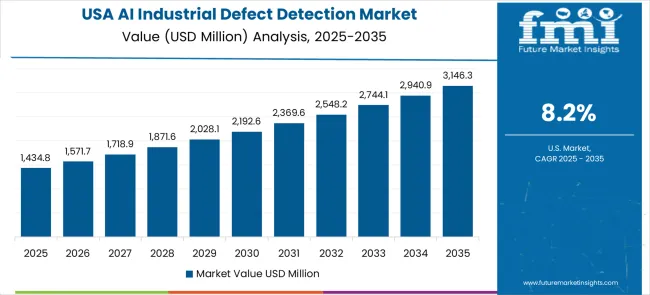
Demand for AI industrial defect detection systems in the U.S. is expanding at a CAGR of 8.2%, driven by established advanced manufacturing industries and growing emphasis on artificial intelligence technology innovation. Large manufacturing companies and technology providers are implementing comprehensive AI inspection capabilities to serve diverse production and quality control requirements. The market benefits from established AI development networks and professional training programs that support various manufacturing and quality assurance applications.
Advanced manufacturing industry leadership is enabling standardized AI technology utilization across multiple production types, providing consistent quality performance and comprehensive inspection coverage throughout regional manufacturing markets. Professional development and certification programs are building specialized technical expertise among manufacturing and AI engineers, enabling effective AI defect detection utilization that supports evolving production requirements.
Demand for AI industrial defect detection systems in the U.K. is projected to grow at a CAGR of 7.3%, supported by established manufacturing technology sectors and growing emphasis on AI-powered quality control capabilities. British manufacturing companies and technology providers are implementing AI inspection equipment that meets industry quality standards and technical requirements. The market benefits from established manufacturing infrastructure and comprehensive training programs for manufacturing professionals.
Manufacturing technology investments are prioritizing advanced AI inspection systems that support diverse production applications while maintaining established quality and technical standards. Professional development programs are building technical expertise among manufacturing personnel, enabling specialized AI defect detection operation capabilities that meet evolving institutional requirements and quality standards.
Revenue from AI industrial defect detection systems in Japan is growing at a CAGR of 6.5%, driven by the country's focus on precision manufacturing technology innovation and ultra-high quality production applications. Japanese manufacturing companies and technology providers are implementing advanced AI inspection systems that demonstrate superior precision reliability and operational excellence. The market is characterized by emphasis on technological perfection, quality assurance, and integration with established precision manufacturing workflows.
Precision manufacturing industry investments are prioritizing innovative AI solutions that combine advanced defect detection technology with precision engineering while maintaining Japanese quality and reliability standards. Professional development programs are ensuring comprehensive technical expertise among manufacturing engineers and quality specialists, enabling specialized precision inspection capabilities that support diverse manufacturing applications and quality requirements.
The AI industrial defect detection market in Europe is forecast to expand from USD 695.3 million in 2025 to USD 1,585.7 million by 2035, registering a CAGR of 8.6%. Germany will remain the largest market, holding 38.5% share in 2025, easing to 38.0% by 2035, supported by strong automotive manufacturing infrastructure and advanced precision engineering applications. The United Kingdom follows, rising from 26.0% in 2025 to 26.5% by 2035, driven by manufacturing technology innovation and AI research advancement. France is expected to maintain stability around 19.5%, reflecting steady manufacturing investment patterns. Italy maintains stability at around 10.0%, supported by automotive and fashion manufacturing quality enhancement, while Spain grows from 4.5% to 5.0% with expanding manufacturing modernization and AI adoption initiatives. BENELUX markets ease from 1.3% to 1.2%, while the remainder of Europe hovers near 0.2%-0.3%, balancing emerging Eastern European manufacturing growth against mature Nordic precision manufacturing markets.
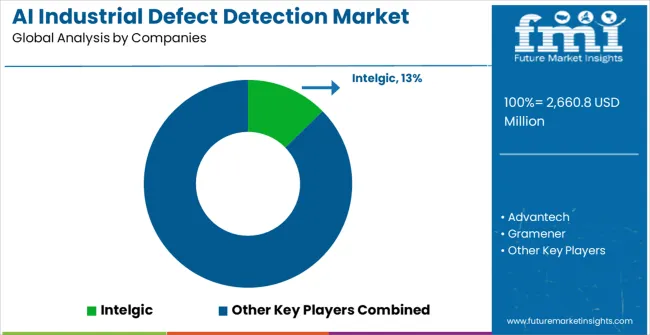
The AI Industrial Defect Detection market is defined by competition among specialized artificial intelligence companies, industrial automation providers, and computer vision solution developers. Companies are investing in advanced machine learning algorithm development, detection accuracy optimization, system integration improvements, and comprehensive industrial application capabilities to deliver reliable, accurate, and cost-effective quality control solutions. Strategic partnerships, technological innovation, and market expansion are central to strengthening product portfolios and market presence.
Intelgic offers comprehensive AI-powered inspection solutions with established machine learning expertise and industrial application capabilities. Advantech provides extensive industrial computing equipment with focus on AI integration and manufacturing automation solutions. Gramener delivers specialized artificial intelligence consulting with emphasis on manufacturing quality control applications. GFT specializes in digital transformation services with advanced AI implementation integration.
Kili Technology offers AI training data solutions with focus on computer vision and defect detection applications. Optimax provides precision manufacturing services with emphasis on quality control and inspection optimization. Cognex delivers established machine vision equipment with advanced AI integration capabilities. Omron, IVISYS, National Instruments, Siemens, Huawei Enterprise, Extreme Vision, NeuroSYS, Mobidev, TrueFlaw, Averroes, and iMerit offer specialized manufacturing expertise, system reliability, and comprehensive AI development across global and regional industrial automation market segments.
| Item | Value |
|---|---|
| Quantitative Units | USD 2,660.8 million |
| Detection Technology | Defect Detection Based on Deep Learning, Traditional Computer Vision, Unsupervised Learning |
| Application | Electronics Manufacturing, Automobile Manufacturing, Metal Processing, Apparel and Textiles, Packaging, Aerospace and Defense, Photovoltaics, Others |
| Regions Covered | North America, Europe, East Asia, South Asia & Pacific, Latin America, Middle East & Africa |
| Country Covered | China, India, Germany, Brazil, United States, United Kingdom, Japan, and 40+ countries |
| Key Companies Profiled | Intelgic, Advantech, Gramener, GFT, Kili Technology, Optimax, Unilin Group, Huawei Enterprise, Extreme Vision, NeuroSYS, Mobidev, Siemens, TrueFlaw, Averroes, Cognex, Omron, IVISYS, National Instruments, iMerit |
| Additional Attributes | Dollar sales by detection technology and application segment, regional demand trends across major markets, competitive landscape with established AI technology providers and emerging computer vision specialists, customer preferences for different neural network architectures and detection approaches, integration with manufacturing execution systems and quality control protocols, innovations in edge AI processing and real-time inspection technologies, and adoption of automated training features with enhanced defect recognition capabilities for improved production quality workflows. |
The global market is estimated at USD 2,660.8 million in 2025.
It is projected to reach USD 6,071.8 million by 2035.
Expected CAGR is 8.6% over 2025 to 2035.
Deep learning–based detection leads with about 56% share.
Electronics manufacturing leads with 34.0% share.






Our Research Products

The "Full Research Suite" delivers actionable market intel, deep dives on markets or technologies, so clients act faster, cut risk, and unlock growth.

The Leaderboard benchmarks and ranks top vendors, classifying them as Established Leaders, Leading Challengers, or Disruptors & Challengers.

Locates where complements amplify value and substitutes erode it, forecasting net impact by horizon

We deliver granular, decision-grade intel: market sizing, 5-year forecasts, pricing, adoption, usage, revenue, and operational KPIs—plus competitor tracking, regulation, and value chains—across 60 countries broadly.

Spot the shifts before they hit your P&L. We track inflection points, adoption curves, pricing moves, and ecosystem plays to show where demand is heading, why it is changing, and what to do next across high-growth markets and disruptive tech

Real-time reads of user behavior. We track shifting priorities, perceptions of today’s and next-gen services, and provider experience, then pace how fast tech moves from trial to adoption, blending buyer, consumer, and channel inputs with social signals (#WhySwitch, #UX).

Partner with our analyst team to build a custom report designed around your business priorities. From analysing market trends to assessing competitors or crafting bespoke datasets, we tailor insights to your needs.
Supplier Intelligence
Discovery & Profiling
Capacity & Footprint
Performance & Risk
Compliance & Governance
Commercial Readiness
Who Supplies Whom
Scorecards & Shortlists
Playbooks & Docs
Category Intelligence
Definition & Scope
Demand & Use Cases
Cost Drivers
Market Structure
Supply Chain Map
Trade & Policy
Operating Norms
Deliverables
Buyer Intelligence
Account Basics
Spend & Scope
Procurement Model
Vendor Requirements
Terms & Policies
Entry Strategy
Pain Points & Triggers
Outputs
Pricing Analysis
Benchmarks
Trends
Should-Cost
Indexation
Landed Cost
Commercial Terms
Deliverables
Brand Analysis
Positioning & Value Prop
Share & Presence
Customer Evidence
Go-to-Market
Digital & Reputation
Compliance & Trust
KPIs & Gaps
Outputs
Full Research Suite comprises of:
Market outlook & trends analysis
Interviews & case studies
Strategic recommendations
Vendor profiles & capabilities analysis
5-year forecasts
8 regions and 60+ country-level data splits
Market segment data splits
12 months of continuous data updates
DELIVERED AS:
PDF EXCEL ONLINE
Industrial Air Filtration Market Size and Share Forecast Outlook 2025 to 2035
Industrial Air Compressor Market Growth - Trends & Forecast 2025 to 2035
Industrial Air Heater Market
Industrial Nailers Market Size and Share Forecast Outlook 2025 to 2035
Industrial Pails & Drums Market Size and Share Forecast Outlook 2025 to 2035
Industrial Pail Market Analysis, Size, Share & Forecast 2024 to 2034
Industrial Chain Drives Market Size, Growth, and Forecast 2025 to 2035
Industrial Strainers Market Size and Share Forecast Outlook 2025 to 2035
Aircraft Smoke Detection and Fire Extinguishing System Market Size and Share Forecast Outlook 2025 to 2035
GCC Industrial Air Filtration Market Size and Share Forecast Outlook 2025 to 2035
Bone Defect Repair Materials Market Size and Share Forecast Outlook 2025 to 2035
Compressed Air Leak Detection Market Analysis - Size, Share, and Forecast Outlook 2025 to 2035
AI-based Atrial Fibrillation AFib Detection Market Size and Share Forecast Outlook 2025 to 2035
North America Industrial Air Filtration Market Growth - Trends & Forecast 2025-2035
North America Industrial Air Filtration Market Share Analysis
Orthopedic Bone Defect Repair Materials Market Size and Share Forecast Outlook 2025 to 2035
Orthopedic Artificial Bone Defect Repair Materials Market Size and Share Forecast Outlook 2025 to 2035
AI Code Assistant Market Size and Share Forecast Outlook 2025 to 2035
Industrial Grade Electrochemical CO Sensor Market Size and Share Forecast Outlook 2025 to 2035
AI-Based Data Observability Software Market Size and Share Forecast Outlook 2025 to 2035

Thank you!
You will receive an email from our Business Development Manager. Please be sure to check your SPAM/JUNK folder too.
Chat With
MaRIA